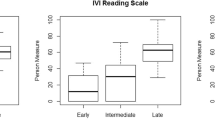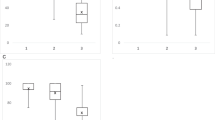Abstract
Background/Objectives
To examine the risk factors for poor vision-related and health-related quality of life (QoL) in patients with neovascular age-related macular degeneration (nAMD) who present for anti-vascular endothelial growth factor (anti-VEGF) therapy.
Methods
In a clinic-based cohort of 547 nAMD patients who presented for treatment, the National Eye Institute Visual Function Questionnaire-25 (NEI-VFQ25), Short-Form 36 (SF-36) and EuroQoL EQ-5D-5L questionnaires were administered to assess vision-related and health-related QoL. Of these, 83 participants were followed up one-year later to provide longitudinal data.
Results
Individuals with mild or moderate visual impairment or blindness at baseline had significantly lower NEI-VFQ-25 scores at follow-up. The presence of ≥3 chronic diseases was associated with lower SF-36 mental component scores (MCS) (p = 0.04) and EQ-VAS scores (p = 0.05). Depressive symptoms were associated with significantly lower MCS (p < 0.0001) and EQ-VAS scores (p = 0.02). Individuals with versus without impaired basic activities of daily living (ADLs) exhibited NEI-VFQ-25 and EQ-VAS scores that were 10.96 (p = 0.03) and 0.13 (p = 0.02) points lower. Those with impaired instrumental ADLs scored 11.62 (p = 0.02), 13.13 (p < 0.0001) and 15.8 (p = 0.0012) points lower in the NEI-VFQ-25, SF-36 physical component score and EQ-5D-5L summary score, respectively.
Conclusions
The QoL of nAMD patients is affected by visual acuity as well as patients’ medical history, mental health and functional status.
This is a preview of subscription content, access via your institution
Access options
Subscribe to this journal
Receive 18 print issues and online access
$259.00 per year
only $14.39 per issue
Buy this article
- Purchase on Springer Link
- Instant access to full article PDF
Prices may be subject to local taxes which are calculated during checkout
Similar content being viewed by others
Data availability
Data are available upon reasonable request. Deidentified participant data will be available upon request made to the corresponding author.
References
Wong WL, Su X, Li X, Cheung CMG, Klein R, Cheng C-Y, et al. Global prevalence of age-related macular degeneration and disease burden projection for 2020 and 2040: a systematic review and meta- analysis. Lancet. 2014;2:106–16.
Department of Health. PBS Expenditure and Prescriptions Report 1 July 2019 to 30 June 2020. (PBS Information Management Section, Canberra, ACT, 2020.
Chatziralli I, Mitropoulos P, Parikakis E, Niakis D, Labiris G. Risk factors for poor quality of life among patients with age-related macular degeneration. Semin Ophthalmol. 2017;32:772–80.
Inan S, Cetinkaya E, Duman R, Dogan I, Inan UU. Quality of life among patients with age-related severe macular degeneration assessed using the NEI-VFQ, HADS-A, HADS-D and SF-36 tests. A cross-sectional study. Sao Paulo Med J. 2019;137:25–32.
Senra H, Balaskas K, Mahmoodi N, Aslam T. Experience of Anti-VEGF treatment and clinical levels of depression and anxiety in patients with wet age-related macular degeneration. Am J Ophthalmol. 2017;177:213–24.
Choudhury F, Varma R, Klein R, Gauderman J, Azen PA, McKean-Cowden R. Age-related macular degeneration and quality of life in Latinos: The Los Angeles Latino Eye Study. JAMA Ophthalmol. 2016;134:683–90.
Paulus YM, Jefferys JL, Hawkins BS, Scott AW. Visual function quality of life measure changes upon conversion to neo-vascular age-related macular degeneration in second eyes. Qual Life Res. 2017;26:2139–51.
Elshout M, Webers CA, van der Reis M, de Jong-Hesse Y, Schouten JS Tracing the natural course of visual acuity and quality of life in neovascular age-related macular degeneration: a systematic review and quality of life study. BMC Ophthalmol (2017). https://doi.org/10.1186/s12886-017-0514-3.
Matamoros E, Maurel F, Léon N, Solomiac A, Bardoulat I, Joubert M, et al. Quality of life in patients suffering from active exudative age-related macular degeneration: the EQUADE study. Ophthalmologica. 2015;234:151–9.
Williams RA, Brody BL, Thomas RG, Kaplan RM, Brown SI. The psychosocial impact of macular degeneration. Arch Ophthalmol. 1998;116:514–20.
Deteram HD, Liew G, Russell J, Vu KV, Burlutsky G, Mitchell P et al. Dietary antioxidants are associated with presence of intra- and sub-retinal fluid in neovascular age-related macular degeneration after 1 year. Acta Ophthalmol (2020). https://doi.org/10.1111/aos.14394.
Mangione C, Lee P, Gutierrez PR, Spritzer K, Berry S, Hays RD, et al. Development of the 25-item national eye institute visual function questionnaire. Arch Ophthalmol. 2001;119:1050–8.
Ware JE. SF-36 Physical and mental health summary scales: a user’s manual. Boston, MA: The Health Institute, New England Medical Centre; 1994.
The EuroQol Group. EuroQol – a new facility for the measurement of health-related quality of life. Health Policy. 1990;16:199–208.
EuroQol. Choosing a value set. 2018. https://euroqol.org/eq-5d-instruments/eq-5d-3l-about/valuation/choosing-a-value-set/.
Duke University Centre for the Study of Aging and Human Development. OARS Multidimensional Functional Assessment Questionnaire. 1975.
Radloff L. The CESD-D scale: a self-report depression scale for research in general population. Appl Psychol Meas. 1977;1:385–401.
Barton B, Peaton J. Medical Statistics: A guide to SPSS, Data Analysis and Critical Appraisal. 2nd edn. Sydney: Blackwell Publishing; 2014.
Finger RP, Guymer RH, Gillies MC, Keefe JE. The impact of anti-vascular endothelial growth factor treatment on quality of life in neovascular age-related macular degeneration. Ophthalmology. 2014;121:1246–51.
Zhu M, Wijeyakumar W, Syed AR, Joachim N, Hong T, Broadhead GK, et al. Vision-related quality of life: 12-month aflibercept treatment in patients with treatment-resistant neovascular age-related macular degeneration. Graefs Arch Clin Exp Ophthalmol. 2017;255:475–84.
Finger RP, Daien V, Eldem BM, Talks JS, Korobelnik JF, Mitchell P et al. Anti-vascular endothelial growth factor in neovascular age-related macular degeneration – a systematic review of the impact of anti-VEGF on patient outcomes and healthcare systems. BMC Ophthalmol (2020). https://doi.org/10.1186/s12886-020-01554-2.
Sav A, King MA, Whitty JA, Kendall E, McMillan SS, Kelly F, et al. Burden of treatment for chronic illness: a concept analysis and review of the literature. Health Expect. 2015;18:312–24.
Zhang X, Bullard KM, Cotch MF, Wilson MR, Rovner BW, MgGwin G Jr, et al. Association between depression and functional vision in loss in persons 20 years of age or older in the United States, NHANES 2005-2008. JAMA Ophthalmol. 2013;131:573–81.
Vu KV, Mitchell P, Detaram HD, Burlutsky G, Liew G, Gopinath B Prevalence and risk factors for depressive symptoms in patients with neovascular age-related macular degeneration who present for anti-VEGF therapy. Acta Ophthalmol (2021). https://doi.org/10.1111/aos.14635.
Gopinath B, Liew G, Burlutsky G, Michell P. Age-related macular degeneration and 5-year incidence of impaired activities of daily living. Maturitas. 2014;77:263–6.
Acknowledgements
We would like to acknowledge the Macular Disease Foundation Australia (MDFA) and The University of Sydney, Australia for their support of this study.
Funding
This study received funding from the Macular Disease Foundation Australia (MDFA).
Author information
Authors and Affiliations
Contributions
Research design: KVV, PM, BG; Research execution: HD, KVV, PM; Data interpretation and analysis: KVV, BG, GB; Manuscript preparation: KVV, HD, GL, GB, PM, BG.
Corresponding author
Ethics declarations
Competing interests
The authors declare no competing interests.
Additional information
Publisher’s note Springer Nature remains neutral with regard to jurisdictional claims in published maps and institutional affiliations.
Rights and permissions
Springer Nature or its licensor (e.g. a society or other partner) holds exclusive rights to this article under a publishing agreement with the author(s) or other rightsholder(s); author self-archiving of the accepted manuscript version of this article is solely governed by the terms of such publishing agreement and applicable law.
About this article
Cite this article
Vu, K.V., Mitchell, P., Detaram, H.D. et al. Risk factors for poorer quality of life in patients with neovascular age-related macular degeneration: a longitudinal clinic-based study. Eye 37, 2736–2743 (2023). https://doi.org/10.1038/s41433-023-02407-0
Received:
Revised:
Accepted:
Published:
Issue Date:
DOI: https://doi.org/10.1038/s41433-023-02407-0



